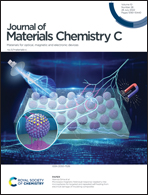Design of potential singlet fission chromophores based on diketofurofuran: an alternative to diketopyrrolopyrrole†
Abstract
Singlet fission (SF) has attracted considerable attention due to its potential in improving energy conversion efficiencies of solar cells, but it suffers from the limited number of SF chromophores. To extend the SF-capable molecular library, a series of symmetric diketofurofuran (DFF) derivatives with the attachment of different aromatic donors, chalcogen substitution and further modifications with terminal substituents have been studied using theoretical calculations. By the frontier molecular orbital analysis and diradical character, potential SF-capable molecules were prescreened according to the diradical character-based design guideline. The results show that furan- and thiophene-based aromatic substituents with a smaller size are good donors to construct SF-capable molecules with donor–acceptor–donor structures. The attached terminal substituents fine-tune the diradical character y0 and SF relevant excited state energies. Moreover, DFFs show relatively higher E(T1) than the diketopyrrolopyrrole (DPP) analogues and can be good alternatives to DPPs as SF-capable molecules. This work will help to get a better understanding of DFF derivatives, and contributes to basic research and practical applications of SF.



 Please wait while we load your content...
Please wait while we load your content...